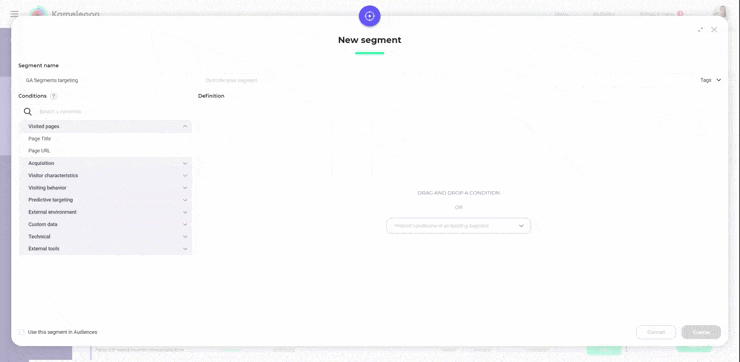
Kameleoon’s two-way integration with Google Analytics now includes segments
Kameleoon is officially the first A/B testing vendor on the market that provides a two-way read and write integration capability, using Google Analytics (GA)'s segment bridge.
Today, Kameleoon announces a major new enhancement to its integration with Google Analytics (GA): a two-way read and write integration capability that uses GA’s segment bridge.
The enhanced GA integration now lets Kameleoon users send data to GA for analytics and retrieve data back into Kameleoon for experiment targeting and personalization campaigns.
It lets users tap into the largest source of user data from Google Analytics, to create highly personalized campaigns and customer journeys, as well as trigger custom offers to your preferred segments, using your Google Analytics segments.
Use cases include:
- Personalize your homepage and/or landing pages based on the keyword the visitor searched for on Google.
- Create automatic pop-ups and/or send emails to customers that have started, but not yet completed a purchase.
- Incentivize users to subscribe, sign in, or create an account based on their login status.
- Cross-sell and upsell products and services based on various account types.
Want to see this enhanced integration in action? Request a demo.
How the two-way integration works
With the two-way integration feature, you can now import all your segments from Google Analytics into your Kameleoon environment, allowing you to personalize the customer’s journey and trigger customized offers to your preferred segments.
Click here for the step-by-step guide to create a bridge between Kameleoon and Google Analytics. It’s updated to help you identify and target visitors within the GA segments.
The integration leverages Kameleoon’s and Google’s API
The breakthrough 2-way integration allows Kameleoon to tag individual visitors within a GA segment using our Kameleoon unique ID. Kameleoon then leverages GA’s reporting API to retrieve all visitors currently belonging to relevant GA segments.
Kameleoon then capitalizes on our existing customer data value bridge which provides an easily accessible method of retrieving segments data keyed to a specific visitor. As this visitor returns to the website, we are able to retrieve an exhaustive list of all GA segments they belong to, in order to use it in subsequent A/B tests or personalizations.
Easily find all the GA segments in Kameleoon’s audience builder
After you build your test and allocate your traffic on Kameleoon, it’s time to target your test by building segments with the segment builder. Kameleoon offers you more than 45 segmentation criteria, one of which is Custom Data, where you will find the GA segments. The Kameleoon segment builder will automatically retrieve all possible GA segments from our back end and display them on a drop down list. Pick the segments you’d like to target from the list. It’s that easy.

The segment builder will automatically transform the configuration into an immediately usable targeting condition.
Finally, when a visitor is targeted, our existing integration will tag them further, allowing the GA user to analyze the outcome of their A/B tests or personalizations directly in their GA dashboard.
Previously, Kameleoon users could send the test name/ID and variation name/ID to Google Analytics, but they could not send segments from Google Analytics or other tools back to Kameleoon for A/B testing and customer profiling. This enhanced new integration makes this two-way connection possible.
Ready to activate the enhanced Google Analytics integration?
Click here for the step-by-step guide to create your two-way integration between Kameleoon and Google Analytics. It’s updated to help you identify and target visitors within the GA segments. Your Customer Success Manager is happy to help. For any questions, email us at [email protected]
Want to see the integration in action? Request a demo.


